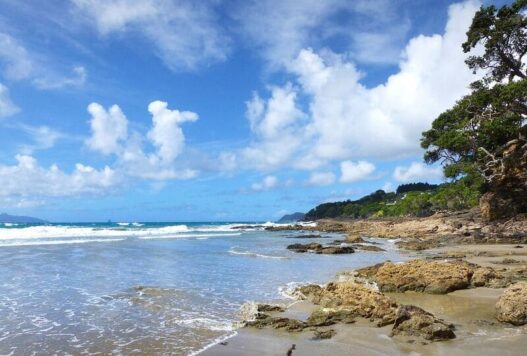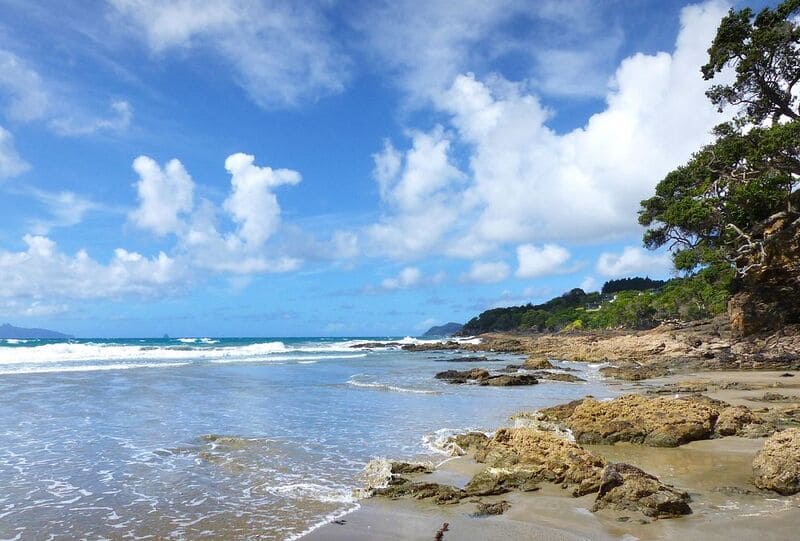Leaving behind the buzz of San José, Costa Rica's highland capital, you'll quickly trade concrete for coastline – traffic lights for howler monkeys and jungle-lined roads. Whether you're headed west to Tamarindo or south to Santa Teresa, the journey is part of the adventure.
Before hitting the road, don't rush through San José. It might not be love at first sight, but this underrated city has its charm. Wander through Barrio Escalante's café scene, check out local art at the Museo de Arte Costarricense, or shop for handmade goods at the Central Market. It's a great place to ease into the culture – especially if you're fresh off a long-haul flight.
The journey to Santa Teresa isn't your typical tourist route. It's an adventure that may involve ferries, jungle roads, and a good sense of humour. But once you arrive? You'll understand why people never stop talking about it.
There's no direct highway from San José to Santa Teresa. You'll likely use a mix of land and sea transportation. That might include shared shuttles, rental cars, buses, or even a domestic flight plus taxi.
Many travellers board the Puntarenas–Paquera ferry, then weave through lush backroads to reach the coast. It's a Costa Rica road trip at its finest—unexpected, scenic, and full of pura vida vibes.
This guide is your full breakdown of how to make the trip: the best transport options to Santa Teresa, where to stay in both cities, packing tips, FAQs, and how to enjoy the journey as much as the destination.
Whether you're budget backpacking, planning a luxury couples retreat, or looking for the best surf hostels, I've got you covered.
Curious how Costa Rica changed my life? Read my love story here.
Let's get started on your route from San José to Santa Teresa – one of the most magical coastlines in Central America.
4 Ways to Travel from San José to Santa Teresa, Costa Rica
Santa Teresa, Costa Rica
Getting to Santa Teresa is part of the adventure. Unlike popular tourist hubs, this route takes you off the beaten path – literally.
You'll pass through mountain valleys, board a scenic ferry across the Gulf of Nicoya, and drive jungle roads all the way to paradise. It's a true Costa Rica road trip – the kind that demands flexibility, patience, and a sense of wonder.
There are 4 main options to reach Santa Teresa: renting a car, taking a shuttle, hopping on a public bus, or flying part of the way. Each offers a different experience depending on your time, budget, and travel style. Let's break them down one by one.
1. Drive a Rental Car
Driving from San José to Santa Teresa is the most scenic and flexible way to experience this side of Costa Rica. You'll navigate highways, board a ferry, and cruise through palm-lined jungle roads all the way to the coast.
The route goes like this: San José → Route 27 → Puntarenas Ferry Terminal → Paquera → Santa Teresa.
This drive gives you the freedom to move at your own pace—stop for roadside fruit stalls, take photos along scenic stretches, or detour to beach towns like Jaco or Montezuma. If you're travelling with surfboards, gear, or a group, a rental car is easily the most convenient way to go. Just make sure to check ferry times and leave early enough to avoid driving in the dark.
It takes around 5 to 6 hours, depending on ferry timing and road conditions.
Your Costa Rica road trip begins on Route 27, a modern toll road heading west out of San José. This part is smooth and quick – perfect for escaping the capital's chaos. From there, you'll arrive in Puntarenas to catch the ferry across the Gulf of Nicoya.
Ferry Tip: Ferries from Puntarenas to Paquera run multiple times a day. It's best to check the latest schedule and arrive early – especially during high season. You can buy tickets online or at the terminal.
Once you disembark in Paquera, the real adventure begins. You'll drive through dusty jungle roads, small beach towns, and the occasional howler monkey sighting. It's rural and raw – everything that makes this destination feel like a hidden gem.
Watch out for potholes and unpaved sections, especially during the rainy season (May to November). A 4×4 is highly recommended, not just for safety but also for comfort. Expect some river crossings and muddy stretches, especially closer to Santa Teresa.
Driving Tips:
- Always travel during daylight – street lighting is rare outside major towns.
- Fill up your tank in Paquera; gas stations are scarce near the coast.
- Download Google Maps offline or use Waze, which works better locally.
This is hands-down the best option for independent travellers, families, or surf lovers who want to explore nearby spots like Montezuma, Malpaís, and Cabuya on their own schedule.
Need wheels? Book your Costa Rica rental car here — pick up in San José and drop off near the Nicoya coast if needed. Booking a rental car in advance saves you the stress of last-minute changes—especially in high season when inventory gets tight.
Look for a flexible pickup/drop-off plan (like picking up in San José and returning it on the Nicoya Peninsula), and always double-check that your car insurance covers unpaved roads.
View Route on Google Maps
2. By Shuttle
If you'd rather skip the hassle of driving or managing connections, taking a shuttle from San José to Santa Teresa is a stress-free alternative. You just hop on, sit back, and enjoy the ride.
Shuttle services are available in both shared and private options. Shared shuttles cost around USD 50–65 per person, while private transfers range from USD 180–250, depending on group size and pick-up point.
Top-rated companies offering this route include Interbus, RideCR, and Tropical Tours Shuttle. These shuttles pick you up directly from your hotel or Airbnb in San José and coordinate ferry schedules to streamline your journey.
The full trip usually takes 6–7 hours, depending on traffic and ferry timing. Most companies include the ferry ride in your fare and assist with luggage throughout the transfer.
This is a perfect option for couples, digital nomads, or solo travellers who want a balance between comfort and budget. It's door-to-door, with no need to navigate ferry terminals or dusty jungle roads on your own.
Shared shuttles usually operate in the morning, so book ahead—especially in high season. Private shuttles offer more flexibility and can cater to late flights or custom stops.
While it's not the cheapest route, the convenience and safety of these air-conditioned vehicles make it well worth considering. You'll meet other travellers along the way, and the drivers often offer local tips.
Pro Tip: Book your shuttle a few days in advance to secure your spot, especially if you're travelling on weekends or holidays.
3. By Public Bus
If you're on a tight budget, public transport in Costa Rica is the most affordable way to get from San José to Santa Teresa. It's not the fastest or smoothest – but it's part of the adventure.
The journey involves multiple steps. First, catch a bus from Terminal 7–10 in San José to Puntarenas. Buses leave every hour and cost around USD 5. Try to catch one early to align with the ferry.
Next, board the Puntarenas to Paquera ferry (CRC 810 / USD 1.50). Ferries depart about every 2 hours, and you can buy tickets at the dock or online via Naviera Tambor.
Once in Paquera, you'll need to catch a bus to Cobano, then transfer to a final bus to Santa Teresa. These buses are operated by Transportes Cobano and the combined fare is under USD 10.
The total travel time is nearly about 8–9 hours, depending on connections. It's a long haul, so pack water, snacks, and patience.
Public buses don't take reservations—so arrive 30–45 minutes early. Weekends and holidays get crowded, especially with locals heading to the Nicoya beaches.
This route is best for budget travellers or backpackers with flexible schedules. It's also a great way to immerse yourself in local life, with scenic coastal and jungle views.
Pro Tip: Use apps like Moovit or Rome2Rio to check bus schedules in real time, or ask your accommodation to help you plan transfers.
While it requires more effort, public transport in Costa Rica is incredibly cost-effective and gets you to Santa Teresa for under USD 20 total.
4. Domestic Flight + Taxi Combo
If you're short on time or craving comfort, this is the fastest way to kick off your Santa Teresa travel experience. From San José International Airport, catch a domestic flight to Tambor Airstrip with Sansa Airlines.
The flight takes just 25–30 minutes and costs around USD 90–120 one way. Flights run multiple times daily, but it's best to book early – seats fill up quickly in peak season.
Once you land at Tambor, grab a taxi or private transfer to Santa Teresa. The scenic ride takes about 1 hour, weaving through lush hills and coastal villages.
Expect to pay USD 50–70 for the taxi. You can also pre-arrange transfers through your hotel or local transport companies for added convenience.
Altogether, this route costs around USD 150–200 per person and cuts your journey down to just 1.5–2 hours total.
This option is ideal for high-end travellers, families with kids, or those catching a tight itinerary. It's also perfect if you're starting your trip in remote beach towns like Santa Teresa and want to skip the bumpy ride.
That said, you'll miss out on the scenic ferry and jungle roads. And if you're travelling with surfboards or bulky luggage, check Sansa's baggage limits – they're strict.
Weather delays can affect regional flights, especially in the rainy season (May–Nov). Always pad your schedule with extra time if you have connections.
For a stress-free and swift start to your Santa Teresa travel, flying is the smoothest (and most scenic) choice.
What's The Best Option For You?
Honestly, choosing how to get to Santa Teresa from San José depends on your budget, travel style, and timeline. While every route has pros and cons, here's how each option stacks up based on your traveller type.
For Solo Travellers And Backpackers
Solo travellers and backpackers often go for the public bus. It's the cheapest way to reach Santa Teresa, even if it takes longer.
You'll get a real local feel and save big, but you'll need to manage your own bags through transfers and ferry crossings.
For Digital Nomads And Couples
Digital nomads and couples usually prefer a shared shuttle. It's affordable, stress-free, and picks you up directly from your hotel or hostel. If you're travelling with surfboards, check with the company beforehand.
For Families
Families with kids might favour a private shuttle or a domestic flight + taxi combo. Both offer convenience, fewer stops, and a comfortable journey without dealing with terminals or transfers
For If You're Short On Time
Luxury travellers or time-conscious explorers will love the speed and ease of flying into Tambor and hopping into a pre-arranged taxi. Yes, it's pricey – but if you're short on time and don't want the hassle, it's your best bet.
Where To Stay In Santa Teresa, Costa Rica
Santa Teresa's accommodation scene blends barefoot luxury with wild nature. You'll find hidden jungle retreats, stylish beachfront villas, and boutique surf lodges that balance comfort with boho charm. Whether you're after a wellness escape or a chic base near the waves, this town delivers.
Luxury Hotels in Santa Teresa, Costa Rica
Looking for the best hotels in Santa Teresa Costa Rica? These top-tier stays combine panoramic ocean views, jungle seclusion, and first-class service – perfect for honeymoons, retreats, or just living the pura vida in style.
1. Nantipa – A Tico Beach Experience
Source
This award-winning resort sits directly on the beach and features spacious bungalows with private plunge pools and hammocks. Expect world-class dining, sunset views, and top-notch hospitality.
BOOK HERE
2. Hotel Casa Chameleon at Mal Pais
Perched on a hillside near Santa Teresa, this adults-only hotel boasts private villas with saltwater plunge pools, open-air design, and a romantic, secluded vibe. It's a dream for couples.
BOOK HERE
3. Florblanca Resort
Located on Playa Santa Teresa, this resort features open-air villas surrounded by tropical gardens. There's an on-site yoga shala, a world-class spa, and direct access to the surf break.
BOOK HERE
Mid-Range Hotels in Santa Teresa, Costa Rica
Mid-range options in Santa Teresa offer the perfect mix of style, comfort, and affordability. Think surfer-style B&Bs, eco-cabanas, and boutique hostels that feel laid-back yet thoughtfully designed. These are especially popular among digital nomads, couples, and long-term travellers.
1. Lua Villas
Source
This tropical-modern stay features open-concept villas and studios, ideal for couples or groups. The outdoor pool, proximity to Playa Hermosa, and fast Wi-Fi make it a digital nomad favourite.
BOOK HERE
2. Zula Inn Aparthotel
Set in lush gardens just off the main strip, Zula Inn offers bungalow-style apartments with kitchens, a shared pool, and a welcoming vibe. Perfect for remote workers who want a peaceful base.
BOOK HERE
3. Fuego Lodge
With a central location and charming rustic design, Fuego Lodge provides the comforts of a boutique stay with strong Wi-Fi, private terraces, and a laid-back atmosphere.
BOOK HERE
Budget-Friendly Hotels in Santa Teresa, Costa Rica
If you're travelling on a budget? Santa Teresa has some great options that don't skimp on location or vibe. You'll find surf hostels, guesthouses, and shared dorms just minutes from the beach.
1. Somos
Somos offers sleek dorms and private rooms with a café, pool, and solid Wi-Fi. A great pick for solo travellers who want to plug into the surf-meets-startup crowd.
BOOK HERE
2. Akih Pods Hostel
This budget-friendly guesthouse offers bunk-style and private rooms, plus a shared kitchen and plenty of chill-out space. Reliable internet and good coffee make it a win for digital nomads.
BOOK HERE
3. Hostel La Posada
Just a short walk from the main strip, this cosy hostel features a pool, hammocks, and clean dorms. It's a no-fuss spot with strong Wi-Fi and a social atmosphere.
BOOK HERE
If you're working remotely, look for stays with strong Wi-Fi and quiet corners. Santa Teresa also has a few laid-back coworking cafés like The Bakery or Zwart Café where you can sip and work.
Where To Stay In San José, Costa Rica (Before Or After Your Trip)
If you're flying in or out of Costa Rica, spending a night in the capital is a smart idea. Whether you want to explore cultural sights or just get a good night's sleep before hitting the road, knowing where to stay in San José Costa Rica can make all the difference.
Best Neighbourhoods To Base Yourself In San Jose:
- Barrio Escalante: San José's trendy foodie district, full of cafés and culture.
- Escazú: An upscale suburb with mountain views and big-name hotels.
- Near the Airport (Alajuela): Convenient for early flights and car rentals.
Grano de Oro Hotel
Grano de Oro Hotel is a Colonial charm in the heart of the city. It is located in central San José, this boutique hotel offers elegant rooms, a rooftop garden, and a fine dining restaurant. Great for couples and cultural explorers.
BOOK HERE
Eco Stay Hostel (Barrio Escalante)
Eco Stay Hostel is budget-friendly, sustainable and social stay, Perfect for digital nomads and solo travellers. With a community kitchen, leafy courtyards, and nearby eateries, it's a hub for creatives.
BOOK HERE
AC Hotel by Marriott Escazú
If you prefer a quiet, polished base with fast Wi-Fi and nearby malls, this is ideal. Escazú is known for its upscale vibe and safety.
BOOK HERE
Hotel Aeropuerto
Located just 10 minutes from the terminal, it's ideal for late arrivals or early flights. Includes free airport shuttle and breakfast.
BOOK HERE
For things to do during your stopover, check out this guide to the Best Things To Do in San José!
What To Pack For Santa Teresa + The Route
Packing for Santa Teresa isn't just about bikinis and board shorts – it's about preparing for a road-ferry-jungle combo that can throw all kinds of curveballs. A suitcase works if you're heading straight to one spot, but a backpack or duffel is way easier to lift, roll, and toss into shuttle trunks or ferry carousels.
The Nicoya Peninsula is hot, dusty, and unpredictable. Think breathable clothes, slip-on shoes, and layers for breezy nights. You'll want more than just flip-flops if you plan to explore on foot – Santa Teresa's roads are mostly unpaved, and the beach paths are often muddy after rain.
Your day bag is your lifeline during the trip. Pack motion sickness meds for the ferry, a refillable water bottle, quick-dry towel, and reef-safe sunscreen. A dry bag is essential if you're hopping on boats or surfing – nobody wants a soggy passport. Add some cash, your charger, and copies of important docs in case you're offline for a while.
Santa Teresa is a barefoot town, but that doesn't mean going unprepared. Bring a sun hat, bug spray, and beach cover-up you can throw on between surf and smoothies. If you're planning to work remotely, don't forget a travel adapter and portable hotspot. The Wi-Fi is decent in most places, but it never hurts to have a backup.
Need a full breakdown of essentials? This Costa Rica Packing List covers everything from jungle hikes to beach lounging—perfect for both minimalist travellers and chronic over-packers.
When it comes to Costa Rica packing tips, the golden rule is: pack light, pack smart, and pack for movement. You're not coming for a city break – you're heading into a rhythm of sandy feet, salty skin, and pura vida. And the lighter you travel, the easier it is to say yes to spontaneous detours.
FAQs About San José To Santa Teresa, Costa Rica
Is it safe to travel from San José to Santa Teresa, Costa Rica?
Yes, it's generally safe to travel from San José to Santa Teresa, especially by day. Whether you're renting a car, taking a shuttle, or hopping on public transport, thousands of travellers make this route safely each year. Just stay alert at ferry terminals, don't leave valuables unattended, and keep an eye on road conditions – especially in the rainy season when the final stretch near Santa Teresa can get rough.
How long is the trip from San José to Santa Teresa?
The journey usually takes 5 to 6 hours by car or shuttle, including the ferry ride from Puntarenas to Paquera. Public transport can take 6 to 8 hours depending on connections, while flying to Tambor plus a short drive cuts the trip down to around 2 hours. Travel time varies with traffic, ferry schedules, and weather, so plan with wiggle room.
Can I drive from San José to Santa Teresa without a 4×4?
Yes, during the dry season (Dec–Apr), a 4×4 isn't essential, but a high-clearance vehicle is recommended for the unpaved, bumpy roads near Santa Teresa. In the rainy season (May–Nov), a 4×4 is highly advisable to handle mud, potholes, and flooded areas, especially for comfort and peace of mind. For tips on choosing your ride, check out our guide on how to rent a car when travelling abroad. Just remember to take it slow—Costa Rican roads reward patience and wide eyes.
Can you get to Santa Teresa by public transport?
Yes, but it's an all-day trip. Take a bus from San José to Puntarenas, then the ferry to Paquera, followed by 2 more bus connections – first to Cóbano, then to Santa Teresa.
What's the best time to visit Santa Teresa, Costa Rica?
The dry season (Dec–Apr) is ideal for sunny beach days, surf, and easy travel, while the green season (May–Nov) brings lush landscapes, fewer crowds, and lower prices. Surfers often prefer shoulder months like May or October for great swells without peak-season chaos.
There's something quietly profound about the transition from San José's busy streets to the barefoot rhythm of Santa Teresa.
Santa Teresa's charm isn't flashy or obvious. It unfolds slowly, like a surf wave catching morning light. Whether it's the silence of the jungle at dawn, the shared smiles between strangers at sunset, or the sound of waves crashing while you sip on a smoothie bowl—you feel it. You realise why so many come here for a week and end up staying for months.
Santa Teresa travel demands a little flexibility. A missed ferry, a dusty detour, or a washed-out road might test your patience. But each curve, each delay, brings you closer to the kind of freedom we often forget we're looking for. By the time you arrive, you're no longer just visiting – you're part of the flow.
So, if you're dreaming of a place where digital nomads work barefoot, surfers line up at dawn, and every sunset feels like a show made just for you – this is it.



















